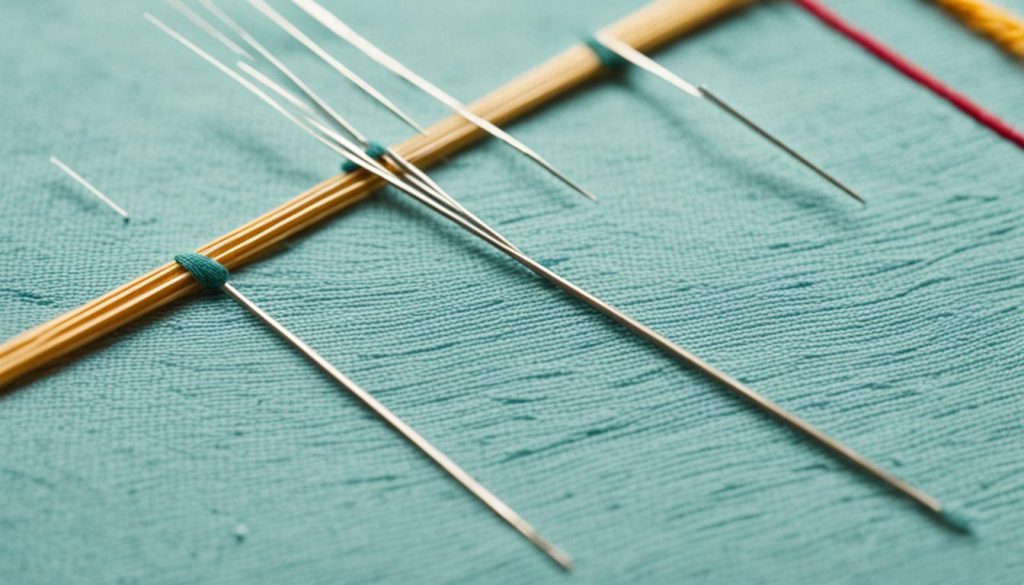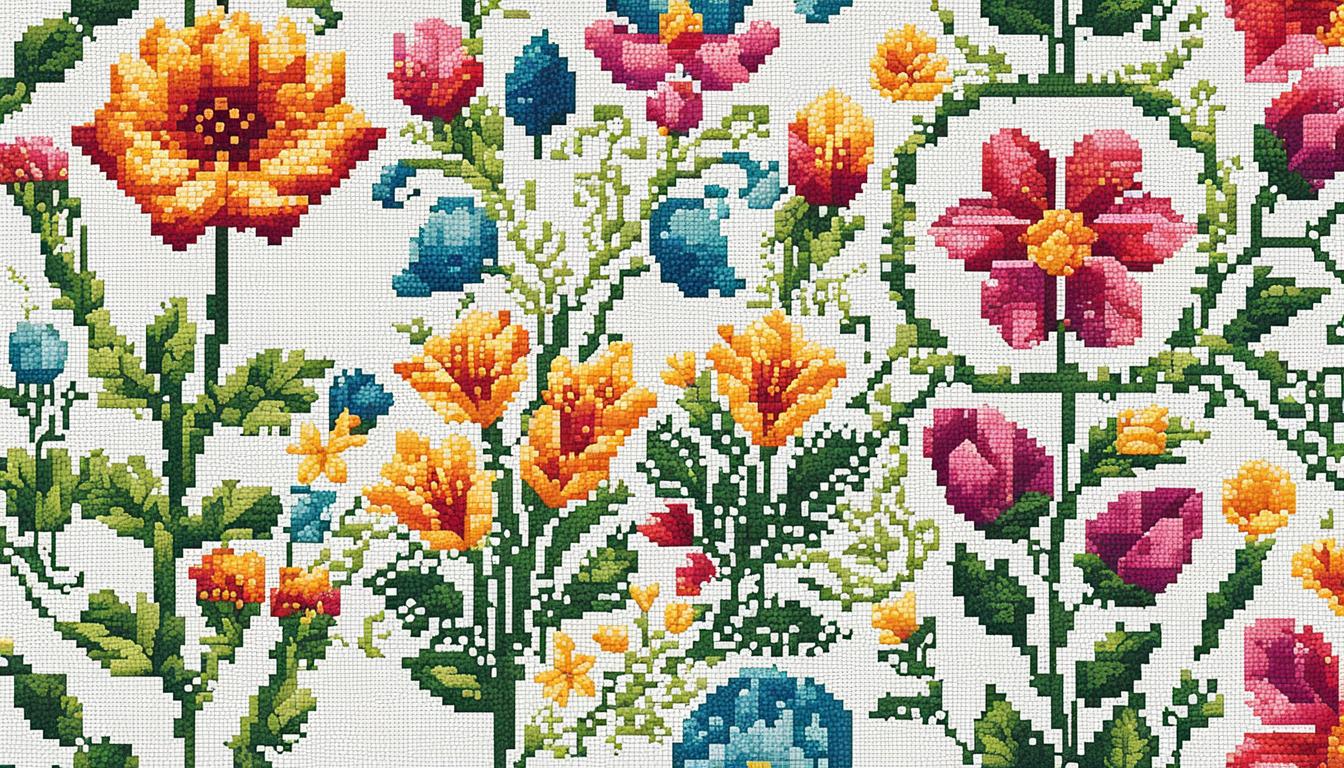Ever thought about using your embroidery needles for cross stitching? Choosing the right needle is key for perfect cross stitch. It all depends on the fabric and threads you’re working with. Let’s dive into how needle selection plays a crucial role in your projects.
The tapestry needle is perfect for cross stitch. It has a blunt end and a big eye. This makes it work well with Aida and other fabrics used in cross stitching. You should know, with cross stitch needles, size works the other way around. This means a larger number actually represents a smaller needle. So, the wrong size can damage your fabric and ruin your thread look. You should pick a size 18 for 6-count Aida. But for 18-count or 36-count fabric, go with a size 28. If you’re allergic to nickel, think about using gold-plated needles.
Key Takeaways
- Choosing the correct needle size is crucial for achieving the best results in your cross stitch projects.
- Tapestry needles with their blunt ends and large eyes are specifically suited for Aida or other open weave fabrics.
- Needle sizes are inversely proportional; a larger number indicates a smaller needle.
- For example, a size 28 needle works best with an 18-count or 36-count fabric.
- Gold-plated needles are a good alternative for those with nickel allergies.
Understanding Different Types of Needles for Embroidery and Cross Stitch
Choosing the right needle for your embroidery and cross stitch can be challenging. There are many options with specific uses. The right needle can make your work easier and look better, especially with various supplies.
Embroidery Needles
Embroidery needles have sharp tips and long eyes. They’re good for different embroidery types. Sizes go from 1 to 12. Size 1 is the biggest, size 12 is the finest. They work well with most fabrics for stitches like backstitch and French knots.
Tapestry Needles
Tapestry needles are great for cross stitch. They have blunt tips and big eyes. This helps with counted cross stitch on fabrics like Aida cloth. Sizes range from 13 to 28, with 13 being big and 28 being fine. Their blunt tips protect your threads and fabric.

Chenille Needles
Chenille needles look like tapestry needles but with a sharp edge. They’re good for chenille embroidery and surface work. They come in sizes 13 to 28. These needles work well with thicker fabrics and add texture. Their big eyes are easy to thread.
Milliner Needles
Milliner needles, or straw needles, are consistent and don’t bulge at the eye. They range from size 1 to 10, offering options for all types of projects. They’re great for embroidery that needs wrapping the thread, like French knots. They’re also good for counted cross stitch and detailed work.
Knowing about each needle type helps you pick the best one for your project. With the right needle and supplies, you gain more control. This leads to a better finish in your embroidery and cross stitch.]}
Why Tapestry Needles are Recommended for Cross Stitch
Tapestry needles are the go-to for both beginners and experts in cross stitching. They are designed for the specific needs of this craft. This makes them very useful for many reasons.
Blunt Tip Benefits
The blunt tip on tapestry needles works well to go through fabric holes. It avoids snagging and splitting threads. This means your stitching is smoother.
Sharp needles could harm the fabric. But tapestry needles offer precise stitching without the risk.
Large Eye for Threading
A key feature of tapestry needles is their large eye. This makes threading easy, from thin to thick threads. It handles metallic and multi-strand threads well. So, it’s great for beginners, making stitching simpler and fun.
Size Variations for Different Fabric Counts
Tapestry needles are available in various sizes to suit different fabric counts. They range from size 24 to 26, perfect for fabrics with 14 to 16 counts.
It’s important to pick the right size. This avoids stretching the fabric and thread wear. The correct size is key for projects of all types.
“Using a slightly bigger needle is recommended for stitching metallic threads to reduce friction, ensuring greater durability of both needle and thread during extensive projects.”
In summary, tapestry needles’ design and features are key for cross stitching. They work well for a wide range of projects, from starting to advanced. Using tapestry needles properly can improve your cross stitch work.
Choosing the Right Needle Size for Cross Stitch Projects
Choosing the right needle size is key for your cross stitch projects to succeed. The right needle will make your stitches better and keep your fabric in good shape. You need to know how needle size affects your work and look at a cross stitch needle size chart for the best results.

Needle Size Chart for Different Fabric Counts
Knowing the right needle size for each fabric count can really help your projects. Here’s a guide to pick the correct needle size:
| Fabric Type | Fabric Count | Recommended Needle Size |
|---|---|---|
| Aida Fabric | 6-count | Size 18 |
| Aida Fabric | 8-count | Size 20 |
| Aida Fabric | 11-count | Size 22 |
| Aida Fabric | 14-count | Size 24 |
| Aida Fabric | 16-count | Size 26 |
| Aida Fabric | 18-count | Size 28 |
| Linen/Evenweave | 28-count | Size 24 |
| Linen/Evenweave | 32-count | Size 26 |
| Linen/Evenweave | 36-count | Size 28 |
| Hardanger Fabric | 22-count | Size 26 |
Impact of Needle Size on Thread and Fabric
The right needle size affects the thread and fabric you use. A needle that’s too big might pull and stretch your fabric. But a too-small needle could come loose, making it hard to sew smoothly. For example, use a size 22 needle for 11-count Aida. But for a 14-count Aida, a size 24 needle works better.
It’s also important to change your needle size when using different materials. For instance, bigger needles help when working with metallic thread, making it easier to thread. But for plastic canvas, a smaller needle can be better, as it cuts down on thread damage. Fine-tuning your needle choice is vital for great results, especially when shopping online for cross stitch supplies. Detailed needle charts help you pick the best needle for every project, keeping your work looking sharp.
Comparing Embroidery and Cross Stitch Needs
Knowing what you need for embroidery and cross stitch is key if you love needlework. The right match of thread, fabric, and needle makes sure your project goes smoothly. This could be a cross stitch with detailed letters or pretty flowers.

Thread Types and Compatibility
The thread you pick is crucial for both embroidery and cross stitch. DMC Stranded Cotton is great for both, but each uses it differently. In embroidery, you might split this thread into strands for various textures. Satin stitch and chain stitch are some common examples.
On the other hand, cross stitch mainly uses the whole thread for a consistent look. It is perfect for basic and back stitches. Matching the right thread to your project enhances how your needlework looks and lasts.
Fabric Compatibility
Your choice of fabric affects how your project turns out. Aida cloth, with its visible weave, is a top pick for cross stitch. It comes in different counts for various project sizes.
For embroidery, linens and cottons are often chosen. These fabrics help the sharp needle tips pierce through easily. Evenweave works well for both. It’s good for those intricate cross stitch or embroidered patterns. Picking the right fabric ensures your work looks neat and accurate.
Stitching Techniques and Needle Performance
The way you stitch in embroidery and cross stitch means you need the right needles. Cross stitch uses tapestry needles, which are thick with blunt tips. They go between the weaves without damaging the threads.
Embroidery, on the other hand, benefits from sharp crewel needles. They make detailed work like French knots look great. Milliner needles can be useful too. They’re great for techniques that need more than one wrap. Choosing the correct needle type helps your stitching go smoothly.
Understanding these needs helps in selecting the right tools. This way, your handiwork will be both beautiful and well-crafted.
Expert Tips on Selecting Needles for Cross Stitch
Choosing the right needle is key for great cross stitch results. The needle size should match the fabric count. For instance, use a size 24 needle with 14 count Aida fabric. For 16 count, you might need a size 26. And for 18 count, go for a size 28.

Using top-quality accessories makes a big difference. Brands like Bohin, DMC, Clover, and John James offer great needles. The right needle size keeps your stitches neat and the thread and fabric strong.
Check your needles often for wear. Replace them as needed to keep your tools in top shape. Trying different brands helps you pick the one you like best. Having a variety of size needles is also important for different stitching techniques.
| Fabric Count | Recommended Needle Size | Needle Manufacturers |
|---|---|---|
| 14 count Aida | 24 | Bohin, DMC |
| 16 count Aida | 26 | Clover, John James |
| 18 count Aida | 28 | Bohin, Clover |
Using the right needle size helps avoid problems. You won’t have to deal with broken needles or messy stitches. These tips will make your cross stitch projects more fun and rewarding.
Conclusion
Choosing the right needle is crucial in cross stitch. It greatly affects how your work turns out. It doesn’t matter if you’re just starting or if you’re experienced. Knowing about needle types and sizes is key to top-notch stitching.
Explore the many types of needles for cross stitch, from classics to fancy gold-plated ones. Using them can boost your project’s quality. Getting into cross stitch offers not just peace but also hones your hand-eye coordination. So, it’s great for your mind and body.
But, finding the perfect needle is only the beginning. As you learn more, your needle selection will get more specific. Always have a good mix of needles ready for different projects. This way, your cross stitch art will be not just beautiful but also meaningful, whether as gifts or family keepsakes.
Stay involved in the cross stitch scene, whether online or in-person. By being active and updated, you can grow as a crafter. And with the best needle and skills, your projects will bring you happiness for years to come.
